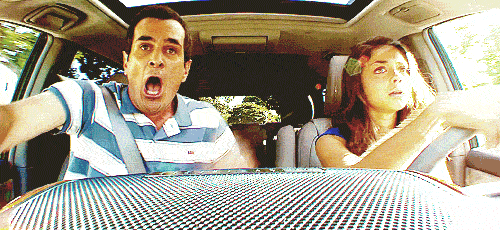To quote my mother: “Teaching a child to drive is more stressful than childbirth.” Gee thanks, mom! Maybe she’s right, and having to teach someone how to drive a car is hard work, but I honestly think that I had the harder job. And I don’t just mean learning how to drive: I mean teaching my parents how to be passengers.
After obtaining my permit, I, like so many other teenagers, was eager to get behind the wheel and hit the open roads. But to avoid a Princess Mia moment, that meant bringing a licensed driver with me everywhere. Which is where good ol’ mom and dad came into the picture. The only problem was, they were used to being in the driver’s seat, not the passenger seat, which created an ~interesting~ dynamic in the car.

I’m going to hazard a guess that I am not alone in this experience. Since your parents love you, and they love themselves (self-preservation is a very strong instinct), it’s not surprising that they are often pretty nervous about sitting in a car that you, their angsty, awkward, can’t-even-remember-where-we-keep-the-spare-towels, teenager is driving. 4,000 pounds of solid and very expensive metal are in your hands, and there is basically nothing that they can do about it.
Or so you thought. Turns out there are plenty of things a passenger can do. Like gasp a lot. Maybe swear occasionally (or more than occasionally, depending on the parent). Brace themselves against the dashboard with both hands. Close their eyes when you go around a corner. Hover their hand over the emergency brake “just in case.” Turn the radio down to an inaudible level so as not to distract you.
Or if they were like my dad, they might decide that quick reflexes are an important driving skill. One of the first times I ever drove a car, around the parking lots and back roads of a local college, he suddenly yelled “Squirrel!” to see how I would respond. Let’s just say that if the squirrel had been real, it would not have survived the burst of acceleration with which I responded. This was a learning opportunity for both of us. I learned that gas pedal ≠ brake pedal, and he learned that passengers should not yell suddenly because drivers sometimes don’t respond calmly to such a disturbance. See? So educational!
The first time driving on real roads is a pretty special experience as well, and is very important for the passenger education process. Remember: if you drive responsibly, you will not hit mailboxes that are six feet from the edge of the road. Same goes for guardrails. And you will not hit oncoming cars if you stay in your lane. But when both you and your parent are in an unfamiliar seat with an unfamiliar view of the road, it definitely feels like all of the above are serious possibilities.
Your parent may be sitting in the passenger seat looking like they’ve just seen a ghost, but this is one fear that they need to overcome. It’s definitely okay to take baby steps. Your parent may even need to have you pull over by the side of the road and resume your old role as passenger for the rest of the day. Not that this ever happened to me, or anything. This is totally fine, as long as after you both fall off the proverbial horse, you don’t wait too long to get back on it!
Because training your parents to be excellent passengers is feasible. If they can make you think that shots don’t hurt and that carrots are good for your eyes, then you can totally convince them that you are a good driver. Start small. Maybe don’t do highways or bridges for a few days, until they look a little less wild-eyed every time you tap the accelerator. Let them keep telling you to hold the wheel at 10 and 2. Listen to their favorite radio station—at a quiet volume, of course—to help them feel calmer.
But if you really want them to learn what being a passenger is like, you will need to add in more advanced driving skills after a while. Change the radio station to something a little louder and funkier. Ask them to keep their eyes open even when you drive above 30 mph. Pass a car on the left. Parallel park a few times (Note: you will never use this skill in real life, but it is a highly thrilling experience for passengers). With each day and each new driving maneuver that they survive, your parents should become better and more relaxed passengers. Someday they might even ask you to drive them somewhere. Or at least not tremble with fear at the prospect.

Following this training program worked for me. After some tense car rides, my parents became model passengers, offering more constructive feedback and fewer terrified shrieks. I won’t pretend that they didn’t cry happy tears every time they reclaimed the driver’s seat, but they also didn’t cry sad tears when they had to sit in the passenger seat. If that’s not a success story, then I don’t know what is. Although I should probably mention that I am the younger child and that my older sister had already started preparing our parents three years earlier. If you are an oldest or only child preparing to train a new set of parental passengers, I have only four cliché words of advice and one punctuation mark to offer to you: You can do it!
